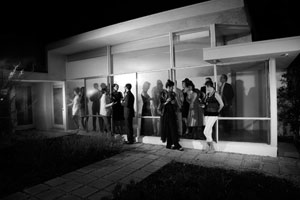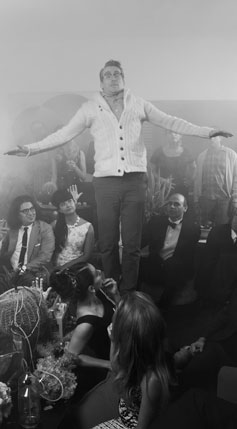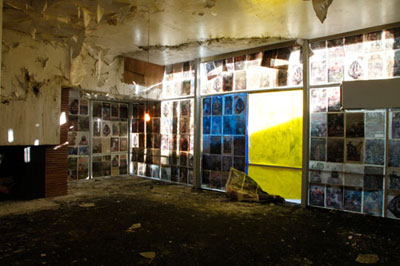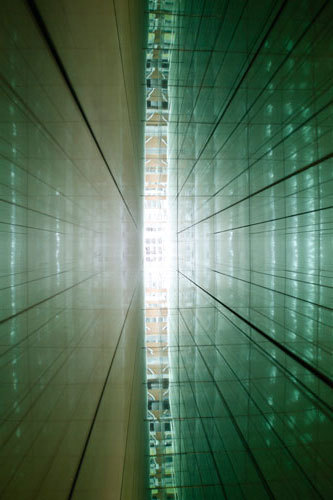
If there are six degrees of separation between people, who do you know at a HBO-Showtime-like studio? There is a conceptual artwork waiting to be made into a cable series. Let's make it happen!
Bright White Underground features the brilliant psychopharmacologist Doctor Arthur Cook and his lovely benefactrix Norma Friedrich, heiress to the Friedrich Rifle fortune, as they embark on a globetrotting romp through the American counterculture from the Beats to the ravers.
My review of Bright White Underground in the current issue of artillery will give you the scoop on the potential plot twists. I will report the results of our cable adventure as we course through Hollywood.
"...Boffo! Brilliant! I have never been to an art show with a greater box office potential. Jonah Freeman and Justin Lowe are producers of the Bright White Underground, an installation for Country Club Projects that has overwhelmed the Buck House in sunny Los Angeles, California. Located two blocks from LACMA and two miles from the studio gates of Paramount Pictures, the Buck House, a Rudolf Schindler creation, is the principal set piece for an epic, globetrotting tale of over-reaching hope, American ambition and page-turning tragedy. Freeman and Lowe have delivered a work of pristine detail and deep emotional experience.
Bright White Underground is sensational in every sense of the word. Hang onto your neural transmitters! It's a wild ride. If I were the president of HBO, I'd be banging loudly on their Modernist front door.
As a totem pole tells a story, the 1934 residential Buck House becomes the narrative drive in the hands of Freeman and Lowe. A compelling potboiler has been achieved by their wit. The script begins in the early Sixties, with golden light, bright clean lines and great hope for our military-industrial complex. Today, as final credits roll, the Buck House is marooned, physically oppressive, psychologically demeaning and void of light. Attention to detail pays off in spades.

With a longer look, the artwork features a large cast of colorful characters. The clean-cut, square-jawed protagonist, Dr. Arthur Cook, is a brilliant young scientist and innovator of Marasa, a psychotropic drug with life-affirming possibilities. He is joined by his financial backer, the lovely Norma Friedrich, heiress to the Friedrich Rifle fortune. Together, they journey through the counterculture of the late Twentieth century. No influence is left unturned.
Our story begins at the end. Each room of the Buck House has been destroyed by decades of inattention, destruction and failure. Concrete floors lift, crack and heave like a San Andreas fault line. Ceilings and walls disintegrate and flake from leaking pipes, mold and the vapors of imagined chemical compounds. Carpets are worn and torn with time, malt liquor, cum, cigarette butts and crushed test tubes. Nook libraries are crammed with reference books whose spines have been torn with overuse. The home is well appointed for a crackhead with a PhD.

Schindler wanted to let the Los Angeles light in. Freeman and Lowe want to keep it out. In one room, the windows are covered with the colored pages of the alternative newspaper Artichoke, a zine for psychic archaeologists and high-minded astral planers. The quiet colors inspire the reverence of stained glass.
The devil is in the details, each advancing the narrative. In one hallway, shipping boxes for cinema reels are stacked along the wall. Water-stained and aged, they obviously have not been moved since 1969, when Dr. Cook bankrolled a big budget sci-fi flop starring Natalie Wood and John Cassavetes. (Freeman and Lowe cleverly clue us to the date by using an obscure and distinctive Warner Bros-Seven Arts logo printed on the boxes.)
Several home improvements have been added to Schindler's original design. One chamber now features a two-way mirror, an observation room to study the effects of the psychotropic on the human nervous system. A closet has been converted to a sound recording room, evidence of growing paranoia. The kitchen, once bright with the smell of California nectarines, now burns with alkaloids and sulfur in a makeshift laboratory. Sunny side up in Hell.
Another room takes us to the Far East when Dr. Cook, on the lam from the Feds, starts a Pan Asian cult. The windows are covered with native-language fliers, re-creating a common medicine-posting wall. The fliers, with phone number tabs to tear, advertise drugs and nurture an idea. One reads, "$eason In Hell", a nod to poet Arthur Rimbaud and his love of escape and opium.
Every junkie would agree. The destructive effect of the installation is emotionally and psychologically compelling. I could not wait to get the hell out of there. As I drove away, in my rear view mirror, I could see John Knuth, the Country Club director, hesitate before he had to crawl back into the gloom.

At the least, this work could serve as a diploma-worthy dissertation for a PhD in theatrical set design and decoration. While Freeman and Lowe have demonstrated their chops, the artists quietly remind us that this is a sculpture. Slicing through the Buck House of Horrors is a portal, a window, a mirrored tunnel that connects the key spaces. What is it? A communication tube to the drug lab? A wormhole to another dimension? The drama-minded artists don't tell us. A similar structure leads nowhere. Is this a narrative clue?
The beauty of artists Freeman and Lowe is not in their tactile detail and skill, but in their subtle storytelling. After badgering through the dark conclusion of the installation, one falls into a flashback, a room of bright optimism. The library offers the beginning of the narrative. Framed photographs, laden with story-driven clues, introduce the central characters and their many influences. High society and science dance to a bongo beat. These fresh grad students are eager to experiment, explore and to be influenced. A wall of books establishes their prolific efforts. The two organic sculptures that center the room may have been their explosive inspiration.
Better than any Emmy Award winning series, Bright White Underground is a fast hop down the American rabbit hole..."
Who do you know at HBO? Who can you send this link to? Let's see what Freeman and Lowe will create with a bigger playpen and a cable series. I will report on the journey of the enterprise. Send me an email at BrightWhite@GordyGrundy.com. We will call this operation Beau Geste: Freeman and Lowe.. Let's do something nice for somebody.
---------------------------
Gordy Grundy is a Los Angeles based artist and writer. His visual and literary works can be found at www.GordyGrundy.com. He is the creator of the cosmology www.FortunaNow.com
Photographs courtesy of Country Club Projects.

